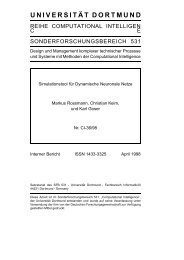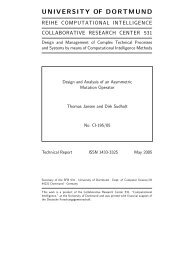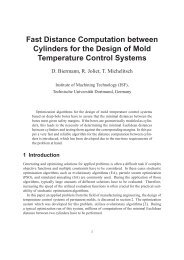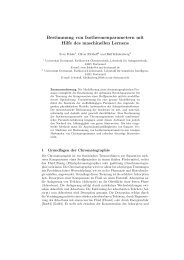Self-Adaptive Genetic Algorithms with Simulated Binary Crossover
Self-Adaptive Genetic Algorithms with Simulated Binary Crossover
Self-Adaptive Genetic Algorithms with Simulated Binary Crossover
Create successful ePaper yourself
Turn your PDF publications into a flip-book with our unique Google optimized e-Paper software.
Population-best objective function value<br />
100<br />
10<br />
1<br />
0.1<br />
0.01<br />
0.001<br />
0.0001<br />
1e-05<br />
1e-06<br />
Correlated ES<br />
Non-isotropic ES<br />
SBX<br />
ES-SBX<br />
1e-07<br />
0 200 400 600 800 1000<br />
Generation number<br />
Figure 17: The best objective function value in the population is shown for four evolutionary algorithms—<br />
real-parameter GAs <strong>with</strong> SBX, non-isotropic (4,100)-ES, and correlated self-adaptive (4,100)-ES, and<br />
(4,100)-ES-SBX—on function F3-1.<br />
MaximizevTx?dk(vTx)v?xk;<br />
much better performance than GAs <strong>with</strong> SBX operator, although no explicit pair-wise correlations among<br />
variables are used in any operator. However, we recognize that the linkage issue may still be a problem in<br />
general, but this simple change in the algorithm seems to fair well in a problem where finding pair-wise<br />
linkage information is important.<br />
5.4 Ridge model<br />
Above problems have tested the ability of algorithms to converge near the true optimum <strong>with</strong> increasing<br />
precision. We now test algorithms for an opposing characteristic. We consider the following function,<br />
which is largely known as the ridge functions in ES literature:<br />
(24)<br />
wherexis theN-dimensional variable vector andvis the ridge axis (or the direction vector specifying the<br />
ridge axis). Thus, the first term is the projection ofxvector along the ridge axis. The term insidekkis<br />
the orthogonal component specifying the distance to the ridge axis. Since the objective is to maximize the<br />
overall function, the subgoals are to maximize the distance along the ridge axis and minimize the distance<br />
to the ridge axis. The parametersdand govern the shape of ridge functions. Higher values ofdmakes<br />
the second term more prominent compared to the first term and therefore makes an algorithm difficult to<br />
progress along the ridge axis. In all simulations here, we use a comparatively larged=1. The parameter<br />
has a direct effect on the fitness landscape. Usually, two values of are commonly used—=2is<br />
known as the parabolic ridge function and=1is known as the sharp ridge function. Here, we shall<br />
consider the parabolic ridge function only.<br />
The ridge functions have their theoretical maximum solution at infinity along the ridge axis in the<br />
search space. Since the maximum solution lies on the ridge axis, this function tests two aspects: converging<br />
ability on the axis, and diverging ability in the direction of the ridge axis. We test the performance of realparameter<br />
GAs <strong>with</strong> SBX and the non-isotropic self-adaptive ES.<br />
17








